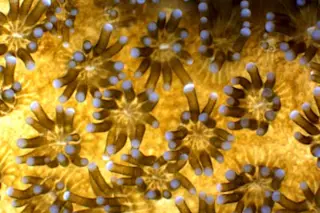The hollow, cylindrical polyps of the coral Stylophora pistillata gather plankton with their tiny tentacles. Photosynthetic algae living within the polyps provide the coral with energy, its vibrant colors, and protection against the acidic byproducts of its respiration. Researchers from Monaco recently discovered the first gene in coral that adjusts its activity based on the time of day [subscription required]: it works twice as hard at night to neutralize acid that the sun-dependent algae cannot remove. Another coral gene responds to a full moon, triggering the simultaneous release of millions of eggs and sperm along a reef.
What is This? The Innards of a Daisy?
It's not a flower, but it does get its nice looks from photosynthesis.

Newsletter
Sign up for our email newsletter for the latest science news
More on Discover
Stay Curious
SubscribeTo The Magazine
Save up to 40% off the cover price when you subscribe to Discover magazine.
Subscribe













